The AMD Ryzen Threadripper 3960X and 3970X Review: 24 and 32 Cores on 7nm
by Dr. Ian Cutress, Andrei Frumusanu & Gavin Bonshor on November 25, 2019 9:05 AM ESTCPU Performance: System Tests
Our System Test section focuses significantly on real-world testing, user experience, with a slight nod to throughput. In this section we cover application loading time, image processing, simple scientific physics, emulation, neural simulation, optimized compute, and 3D model development, with a combination of readily available and custom software. For some of these tests, the bigger suites such as PCMark do cover them (we publish those values in our office section), although multiple perspectives is always beneficial. In all our tests we will explain in-depth what is being tested, and how we are testing.
All of our benchmark results can also be found in our benchmark engine, Bench.
Application Load: GIMP 2.10.4
One of the most important aspects about user experience and workflow is how fast does a system respond. A good test of this is to see how long it takes for an application to load. Most applications these days, when on an SSD, load fairly instantly, however some office tools require asset pre-loading before being available. Most operating systems employ caching as well, so when certain software is loaded repeatedly (web browser, office tools), then can be initialized much quicker.
In our last suite, we tested how long it took to load a large PDF in Adobe Acrobat. Unfortunately this test was a nightmare to program for, and didn’t transfer over to Win10 RS3 easily. In the meantime we discovered an application that can automate this test, and we put it up against GIMP, a popular free open-source online photo editing tool, and the major alternative to Adobe Photoshop. We set it to load a large 50MB design template, and perform the load 10 times with 10 seconds in-between each. Due to caching, the first 3-5 results are often slower than the rest, and time to cache can be inconsistent, we take the average of the last five results to show CPU processing on cached loading.
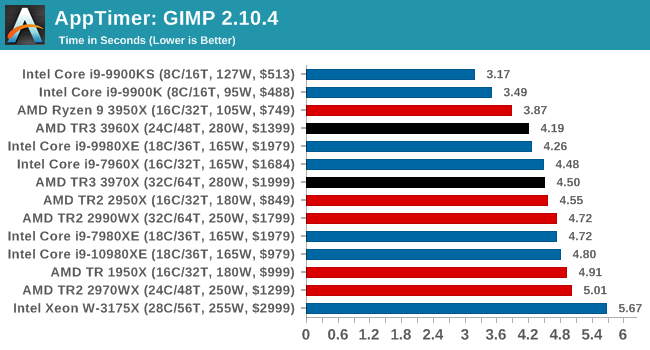
Onto our single threaded tests, and the mainstream hardware with high single thread frequencies wins here, but the 3960X is leading the rest of the pack. Intel's 28-core part here sits last, behind even the 1950X.
3D Particle Movement v2.1: Brownian Motion
Our 3DPM test is a custom built benchmark designed to simulate six different particle movement algorithms of points in a 3D space. The algorithms were developed as part of my PhD., and while ultimately perform best on a GPU, provide a good idea on how instruction streams are interpreted by different microarchitectures.
A key part of the algorithms is the random number generation – we use relatively fast generation which ends up implementing dependency chains in the code. The upgrade over the naïve first version of this code solved for false sharing in the caches, a major bottleneck. We are also looking at AVX2 and AVX512 versions of this benchmark for future reviews.
For this test, we run a stock particle set over the six algorithms for 20 seconds apiece, with 10 second pauses, and report the total rate of particle movement, in millions of operations (movements) per second. We have a non-AVX version and an AVX version, with the latter implementing AVX512 and AVX2 where possible.
3DPM v2.1 can be downloaded from our server: 3DPMv2.1.rar (13.0 MB)
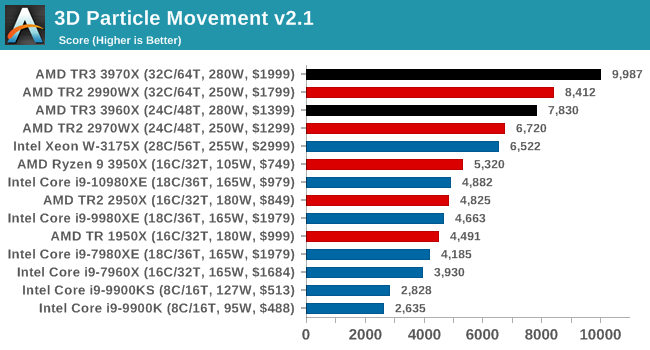
With non-AVX, AMD's floating point units put on a great performance.

This is a workload that can be AVX512 accelerated, and this is the main instance where we can see Intel's CPUs having an advantage.
Dolphin 5.0: Console Emulation
One of the popular requested tests in our suite is to do with console emulation. Being able to pick up a game from an older system and run it as expected depends on the overhead of the emulator: it takes a significantly more powerful x86 system to be able to accurately emulate an older non-x86 console, especially if code for that console was made to abuse certain physical bugs in the hardware.
For our test, we use the popular Dolphin emulation software, and run a compute project through it to determine how close to a standard console system our processors can emulate. In this test, a Nintendo Wii would take around 1050 seconds.
The latest version of Dolphin can be downloaded from https://dolphin-emu.org/
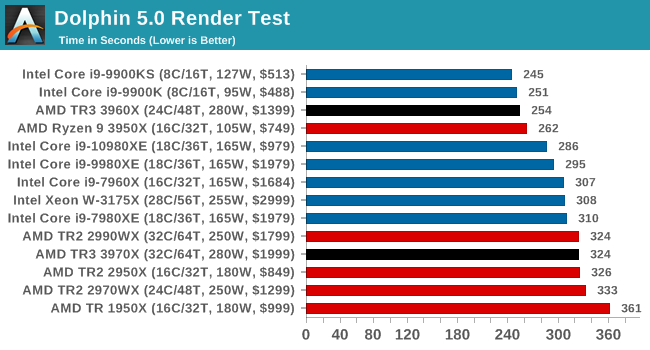
On the single threaded workloads again, and the high frequency mainstream CPUs win here. Interestingly, the 3960X also puts on a really good show, and actually beats our 3950X. Interesting.
DigiCortex 1.20: Sea Slug Brain Simulation
This benchmark was originally designed for simulation and visualization of neuron and synapse activity, as is commonly found in the brain. The software comes with a variety of benchmark modes, and we take the small benchmark which runs a 32k neuron / 1.8B synapse simulation, equivalent to a Sea Slug.
Example of a 2.1B neuron simulation
We report the results as the ability to simulate the data as a fraction of real-time, so anything above a ‘one’ is suitable for real-time work. Out of the two modes, a ‘non-firing’ mode which is DRAM heavy and a ‘firing’ mode which has CPU work, we choose the latter. Despite this, the benchmark is still affected by DRAM speed a fair amount.
DigiCortex can be downloaded from http://www.digicortex.net/
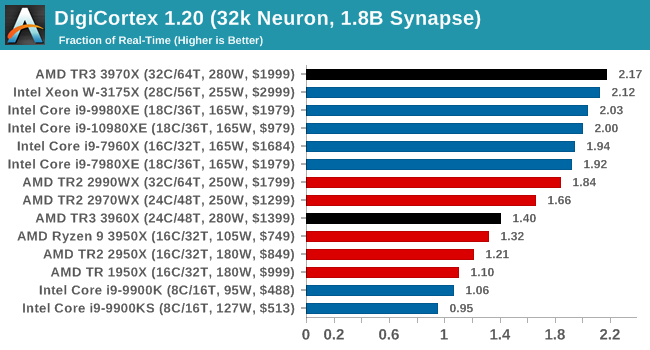
I'm surprised there's that much difference between the 3970X and 3960X here, especially with the 3960X sitting behind the TR2 processors. Might have to re-run this one to double check. But the 3970X puts out a commanding lead.
y-Cruncher v0.7.6: Microarchitecture Optimized Compute
I’ve known about y-Cruncher for a while, as a tool to help compute various mathematical constants, but it wasn’t until I began talking with its developer, Alex Yee, a researcher from NWU and now software optimization developer, that I realized that he has optimized the software like crazy to get the best performance. Naturally, any simulation that can take 20+ days can benefit from a 1% performance increase! Alex started y-cruncher as a high-school project, but it is now at a state where Alex is keeping it up to date to take advantage of the latest instruction sets before they are even made available in hardware.
For our test we run y-cruncher v0.7.6 through all the different optimized variants of the binary, single threaded and multi-threaded, including the AVX-512 optimized binaries. The test is to calculate 250m digits of Pi, and we use the single threaded and multi-threaded versions of this test.
Users can download y-cruncher from Alex’s website: http://www.numberworld.org/y-cruncher/
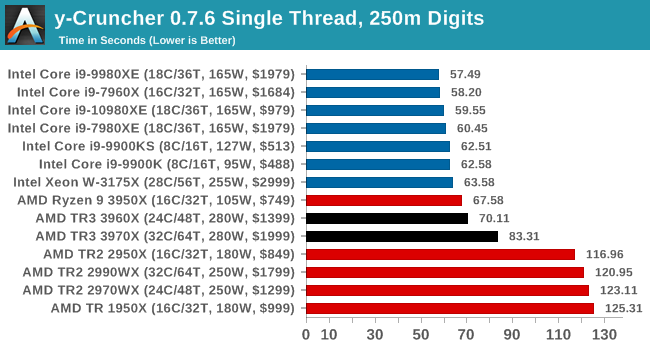
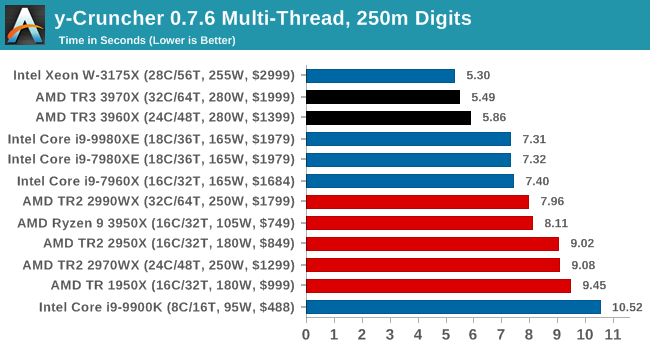
y-Cruncher is also AVX-512 accelerated, however when all the 32 threads come together in MT mode on AVX2, having that many pushes through 18 cores with AVX-512.
Agisoft Photoscan 1.3.3: 2D Image to 3D Model Conversion
One of the ISVs that we have worked with for a number of years is Agisoft, who develop software called PhotoScan that transforms a number of 2D images into a 3D model. This is an important tool in model development and archiving, and relies on a number of single threaded and multi-threaded algorithms to go from one side of the computation to the other.
In our test, we take v1.3.3 of the software with a good sized data set of 84 x 18 megapixel photos and push it through a reasonably fast variant of the algorithms, but is still more stringent than our 2017 test. We report the total time to complete the process.
Agisoft’s Photoscan website can be found here: http://www.agisoft.com/

New records for Photoscan as well.












245 Comments
View All Comments
Silma - Monday, November 25, 2019 - link
Not.Congrats to AMD on great processors, but the consumer market for $1,4-$2k processors is super tiny.
Despite the current generation of AMD processors for desktops being arguably superior to those of Intel, in the financials, Intel still destroys AMD and it is indeed a bloodbath.
In my opinion, AMD would hurt Intel much more, and in the end earn more money, if it priced its offerings lower, for consumer processors as well as datacenter processors.
sgeocla - Monday, November 25, 2019 - link
Not that small.>> Workstations are a growing market segment and have been for quite some time. They run 24-7, are extremely reliable, and have features and specifications you can’t find in a PC. Therefore, workstations can command high price points because of the high expectations users have for them. Our research shows the market size for workstations is approximately 5.3 million units, about 2% of the total PC market, and brings in over $10 billion dollars a year, almost 2.5% of the PC market total, which indicates the average selling price (ASP) is higher than the ASP of a PC.
https://gfxspeak.com/2019/05/13/stands-for-worksta...
melgross - Monday, November 25, 2019 - link
Very small. The more cores, the smaller the market. What are so many cores good for? Video editing, huge databases. Financial transactions, which the chips are not likely to be used for.For most everyone else, 8 cores is still the sweet spot.
ShowsOn - Monday, November 25, 2019 - link
The review literally discusses this point:"...Intel has reported that the workstation market has a potential $10B a year addressable market, so it is still worth pursuing. While I have no direct quotes or data, I remember being told for several generations that Intel’s best-selling HEDT processors were always the highest core count, highest performance parts that money could buy. These users wanted off-the-shelf hardware, and were willing to pay for it – they just weren’t willing to pay for enterprise features...Now that we can get better performance at $1999 with 32 cores, assuming AMD can keep stock of the hardware, it stands to reason that this market will pick up interest again."
twtech - Monday, November 25, 2019 - link
They need to partner with a workstation vendor such as Dell, HP, etc. - or pick/create a company to partner with. Big businesses like to have a reliable single vendor they can deal with for all their server and workstation hardware, including support.eek2121 - Monday, November 25, 2019 - link
They really need Dell.xrror - Tuesday, November 26, 2019 - link
Sadly Dell always seems anti-AMD - or I guess more accurately they absolutely will not do anything that could jeopardize receiving Intel's contrarevenue.eek2121 - Monday, November 25, 2019 - link
Pretty much anybody that does graphics, video, etc. has a need for these CPUs. A large portion of professional Youtubers use blender or similar applications (that scale perfectly) to render things like 3d animations and the like. On the contrary. The market for these types of CPUs is larger than the gaming market. AMD's biggest obstacle here is getting prebuilt OEM systems built with sufficient cooling. Not many folks in that audience are going to build their own PC.melgross - Monday, November 25, 2019 - link
Nope. Graphics apps don’t use all these cores. I run that stuff. Neither do apps like Photoshop. If sometimes they use most cores, the usage ore core I’d down around 20% in spurts. Fewer cores simply have higher per core usage.As I said, video rendering is about the only thing that most users will find using a lot of cores. Even multasking doesn’t use 16 or more cores efficiently.
It’s also interesting that years ago, the argument was too much power. 150 Watters was considered to be on the high side, and not in a good way. Now these cores are moving to 300 watts, and nobody is saying anything.
Jimbo Jones - Tuesday, November 26, 2019 - link
Video rendering3D rendering
3D animation where physics calculation is need (cloth, particles, etc)
Particle simulations for 3D animation / work / science
Game creation / compiling / baking
Progamming (compiling)
VFX -- after effects, etc
Gaming while rendering out any of the above at the same time
Doing more than one thing at a time (Intel users close all their apps to game, lol)
Gaming while streaming
Youtube content creation (requires video rendering and encoding)
Digital audio workstations
To name a couple ...
I actually read someone on another comment feed defending Intel by saying "CPU's aren't even important these days anyway!" -- the desperation of fanbois to grasp at straws to defend the indefensible is hilarious ... right Mel?